4WD TOYOTA HILUX 2020 (in English) User Guide
[x] Cancel search | Manufacturer: TOYOTA, Model Year: 2020, Model line: HILUX, Model: TOYOTA HILUX 2020Pages: 744, PDF Size: 108.13 MB
Page 379 of 744
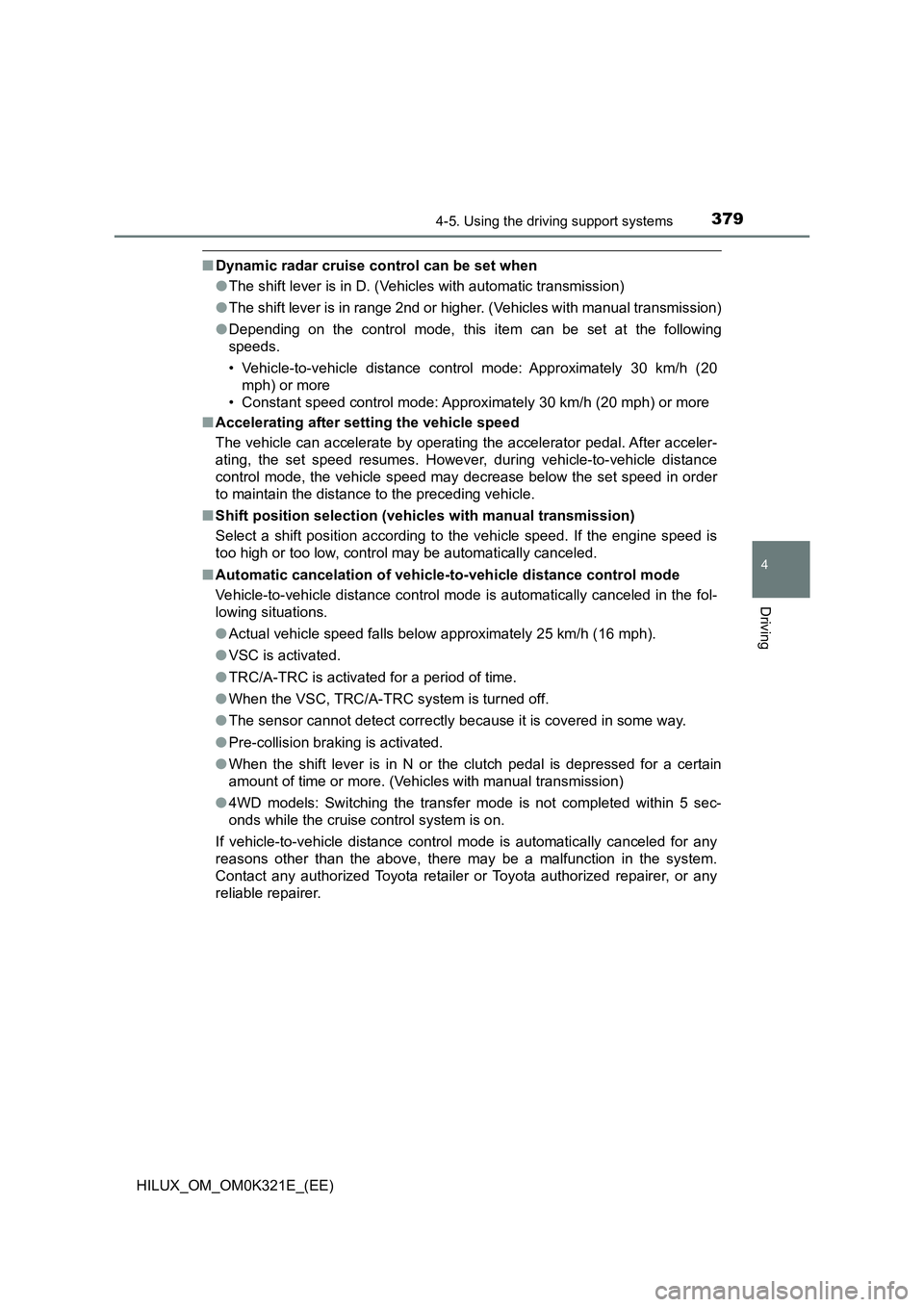
3794-5. Using the driving support systems
4
Driving
HILUX_OM_OM0K321E_(EE)
■Dynamic radar cruise control can be set when
● The shift lever is in D. (Vehicles with automatic transmission)
● The shift lever is in range 2nd or higher. (Vehicles with manual transmission)
● Depending on the control mode, this item can be set at the following
speeds.
• Vehicle-to-vehicle distance control mode: Approximately 30 km/h (20
mph) or more
• Constant speed control mode: Approximately 30 km/h (20 mph) or more
■ Accelerating after setting the vehicle speed
The vehicle can accelerate by operating the accelerator pedal. After acceler-
ating, the set speed resumes. However, during vehicle-to-vehicle distance
control mode, the vehicle speed may decrease below the set speed in order
to maintain the distance to the preceding vehicle.
■ Shift position selection (vehicles with manual transmission)
Select a shift position according to the vehicle speed. If the engine speed is
too high or too low, control may be automatically canceled.
■ Automatic cancelation of vehicle-to-vehicle distance control mode
Vehicle-to-vehicle distance control mode is automatically canceled in the fol-
lowing situations.
● Actual vehicle speed falls below approximately 25 km/h (16 mph).
● VSC is activated.
● TRC/A-TRC is activated for a period of time.
● When the VSC, TRC/A-TRC system is turned off.
● The sensor cannot detect correctly because it is covered in some way.
● Pre-collision braking is activated.
● When the shift lever is in N or the clutch pedal is depressed for a certain
amount of time or more. (Vehicles with manual transmission)
● 4WD models: Switching the transfer mode is not completed within 5 sec-
onds while the cruise control system is on.
If vehicle-to-vehicle distance control mode is automatically canceled for any
reasons other than the above, there may be a malfunction in the system.
Contact any authorized Toyota retailer or Toyota authorized repairer, or any
reliable repairer.
Page 380 of 744
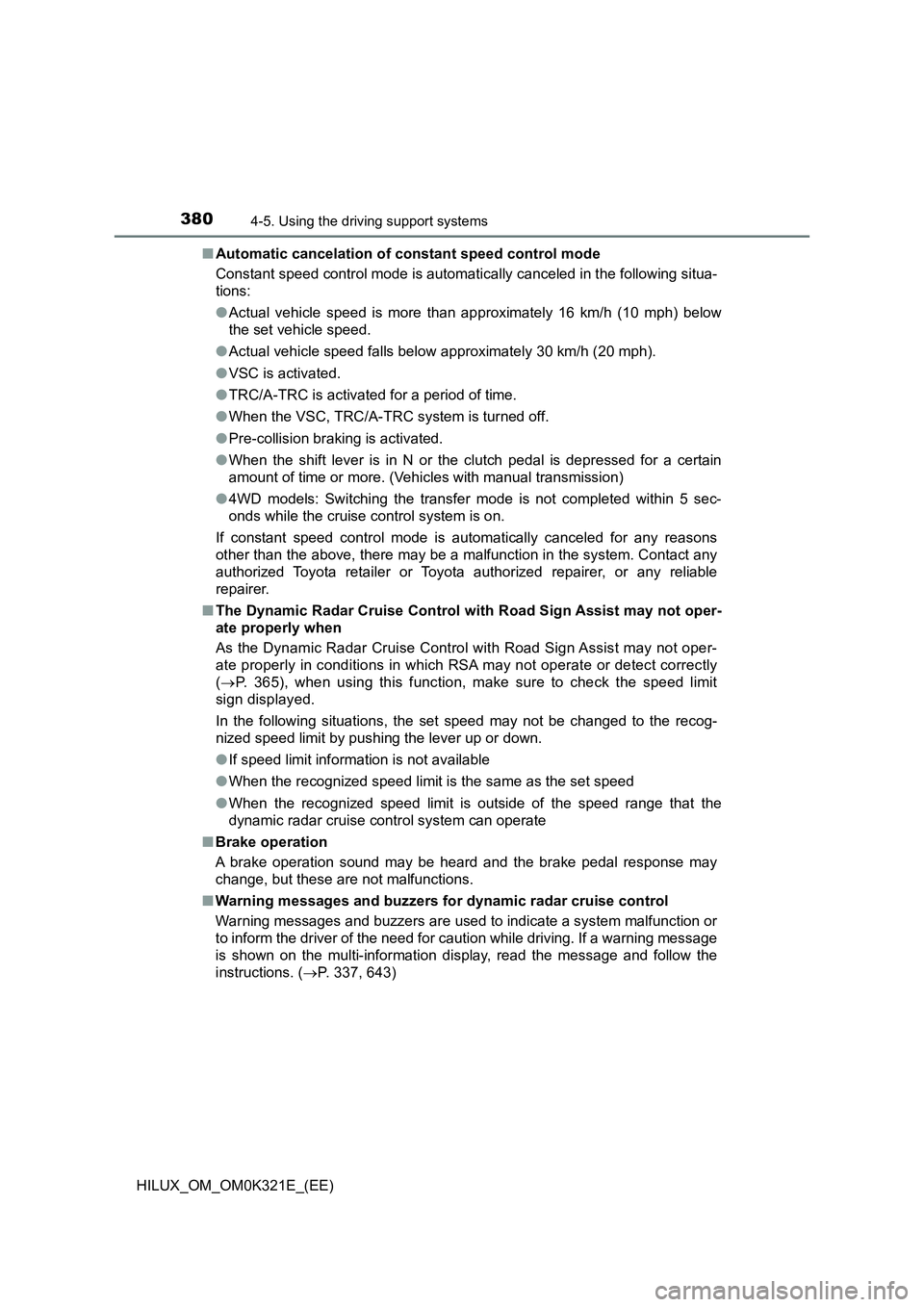
3804-5. Using the driving support systems
HILUX_OM_OM0K321E_(EE)
■ Automatic cancelation of constant speed control mode
Constant speed control mode is automatically canceled in the following situa-
tions:
● Actual vehicle speed is more than approximately 16 km/h (10 mph) below
the set vehicle speed.
● Actual vehicle speed falls below approximately 30 km/h (20 mph).
● VSC is activated.
● TRC/A-TRC is activated for a period of time.
● When the VSC, TRC/A-TRC system is turned off.
● Pre-collision braking is activated.
● When the shift lever is in N or the clutch pedal is depressed for a certain
amount of time or more. (Vehicles with manual transmission)
● 4WD models: Switching the transfer mode is not completed within 5 sec-
onds while the cruise control system is on.
If constant speed control mode is automatically canceled for any reasons
other than the above, there may be a malfunction in the system. Contact any
authorized Toyota retailer or Toyota authorized repairer, or any reliable
repairer.
■ The Dynamic Radar Cruise Control with Road Sign Assist may not oper-
ate properly when
As the Dynamic Radar Cruise Control with Road Sign Assist may not oper-
ate properly in conditions in which RSA may not operate or detect correctly
( P. 365), when using this function, make sure to check the speed limit
sign displayed.
In the following situations, the set speed may not be changed to the recog-
nized speed limit by pushing the lever up or down.
● If speed limit information is not available
● When the recognized speed limit is the same as the set speed
● When the recognized speed limit is outside of the speed range that the
dynamic radar cruise control system can operate
■ Brake operation
A brake operation sound may be heard and the brake pedal response may
change, but these are not malfunctions.
■ Warning messages and buzzers for dynamic radar cruise control
Warning messages and buzzers are used to indicate a system malfunction or
to inform the driver of the need for caution while driving. If a warning message
is shown on the multi-information display, read the message and follow the
instructions. ( P. 337, 643)
Page 385 of 744

3854-5. Using the driving support systems
4
Driving
HILUX_OM_OM0K321E_(EE)
■Cruise control can be set when
● The shift lever is in the D or range 4 or higher of S has been selected. (vehi-
cles with automatic transmission)
● Vehicle speed is above approximately 40 km/h (25 mph)*1 or 30 km/h (20
mph)*2.
*1: Except for diesel engine (vehicles with water-cooled intercooler)
*2: For diesel engine (vehicles with water-cooled intercooler)
■ Accelerating after setting the vehicle speed
● The vehicle can be accelerated normally. After acceleration, the set speed
resumes.
● Even without canceling the cruise control, the set speed can be increased
by first accelerating the vehicle to the desired speed and then pushing the
lever down to set the new speed.
■ Automatic cruise control cancelation
Cruise control will stop maintaining the vehicle speed in any of the following
situations:
● Actual vehicle speed falls more than approximately 16 km/h (10 mph) below
the preset vehicle speed.
At this time, the memorized set speed is not retained.
● Actual vehicle speed is below approximately 40 km/h (25 mph)*1 or 30 km/h
(20 mph)*2.
● VSC is activated. (if equipped)
● 4WD models: Switching the transfer mode is not completed within 5 sec-
onds while the cruise control system is on.
● TRC/A-TRC is activated for a period of time.
● When the VSC, TRC/A-TRC system is turned off. (if equipped)
*1: Except for diesel engine (vehicles with water-cooled intercooler)
*2: For diesel engine (vehicles with water-cooled intercooler)
■ If the warning message for the cruise control is shown on the multi-
information display
Press the “ON-OFF” button once to deactivate the system, and then press
the button again to reactivate the system.
If the cruise control speed cannot be set or if the cruise control cancels imme-
diately after being activated, there may be a malfunction in the cruise control
system. Have the vehicle inspected by any authorized Toyota retailer or
Toyota authorized repairer, or any reliable repairer.
Page 409 of 744
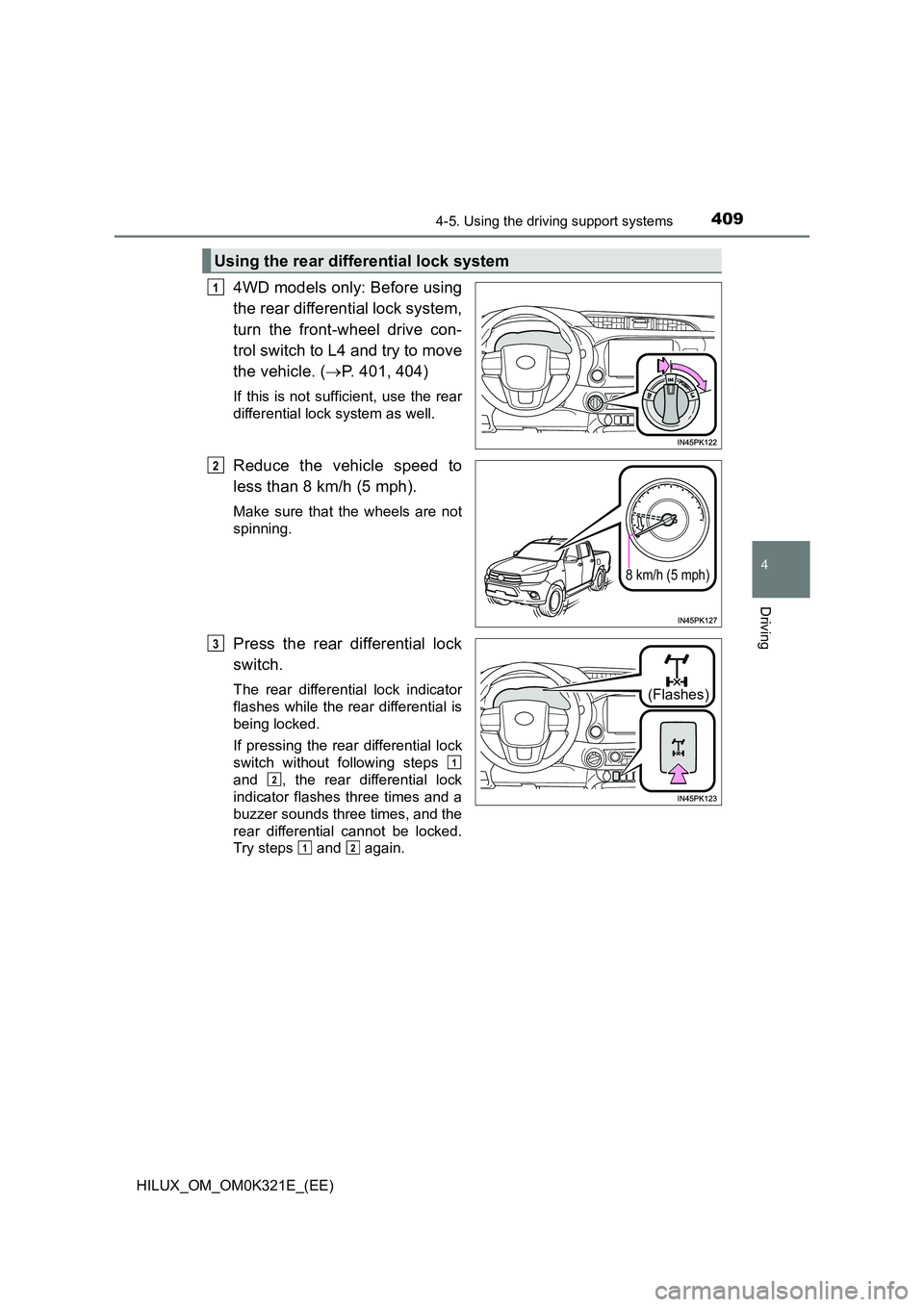
4094-5. Using the driving support systems
4
Driving
HILUX_OM_OM0K321E_(EE)
4WD models only: Before using
the rear differential lock system,
turn the front-wheel drive con-
trol switch to L4 and try to move
the vehicle. ( P. 401, 404)
If this is not sufficient, use the rear
differential lock system as well.
Reduce the vehicle speed to
less than 8 km/h (5 mph).
Make sure that the wheels are not
spinning.
Press the rear differential lock
switch.
The rear differential lock indicator
flashes while the rear differential is
being locked.
If pressing the rear differential lock
switch without following steps
and , the rear differential lock
indicator flashes three times and a
buzzer sounds three times, and the
rear differential cannot be locked.
Try steps and again.
Using the rear differential lock system
1
8 km/h (5 mph)
2
(Flashes)
3
1
2
12
Page 411 of 744
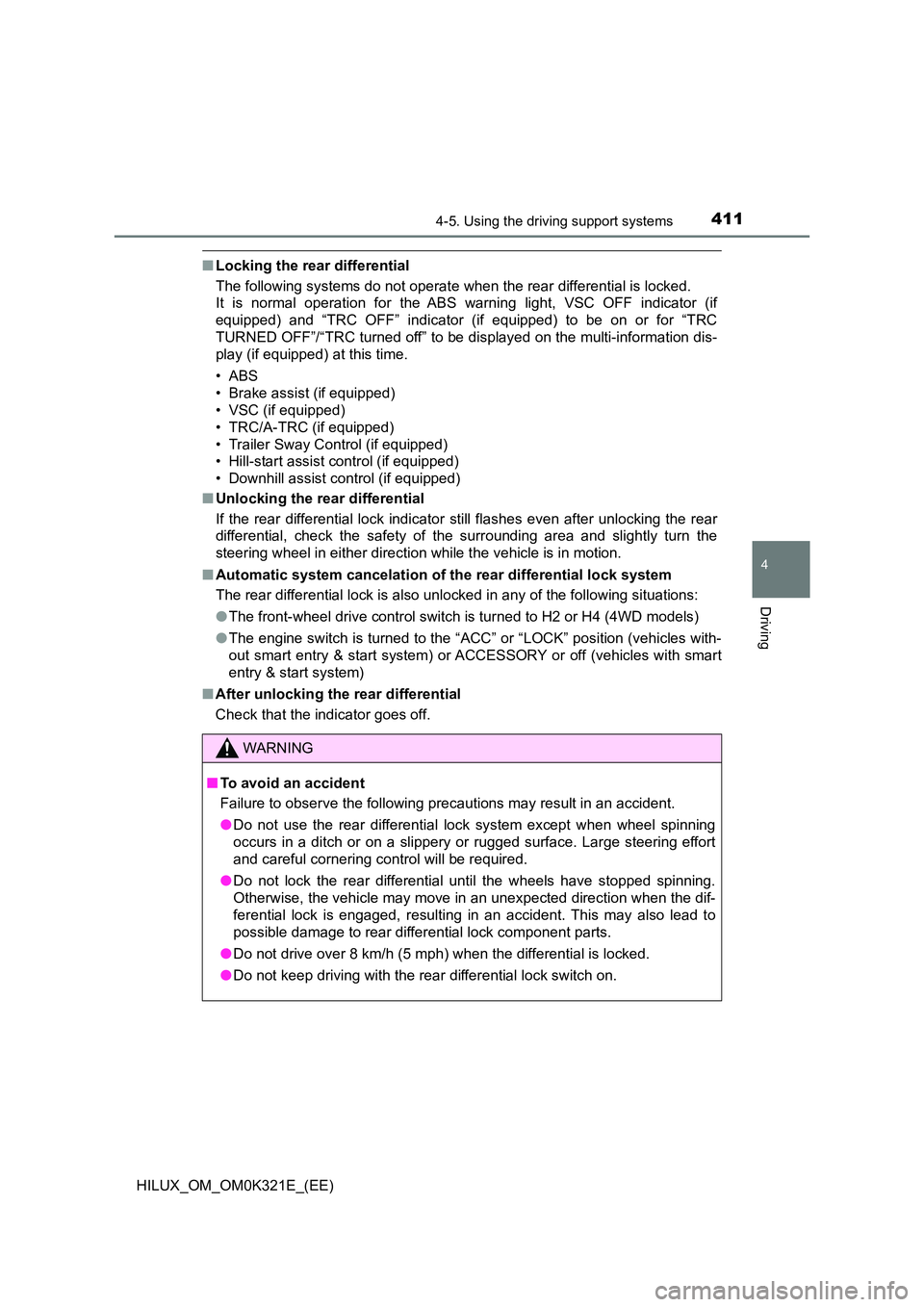
4114-5. Using the driving support systems
4
Driving
HILUX_OM_OM0K321E_(EE)
■Locking the rear differential
The following systems do not operate w hen the rear differential is locked.
It is normal operation for the ABS warning light, VSC OFF indicator (if
equipped) and “TRC OFF” indicator (if equipped) to be on or for “TRC
TURNED OFF”/“TRC turned off” to be displayed on the multi-information dis-
play (if equipped) at this time.
•ABS
• Brake assist (if equipped)
• VSC (if equipped)
• TRC/A-TRC (if equipped)
• Trailer Sway Control (if equipped)
• Hill-start assist control (if equipped)
• Downhill assist control (if equipped)
■ Unlocking the rear differential
If the rear differential lock indicator still flashes even after unlocking the rear
differential, check the safety of the surrounding area and slightly turn the
steering wheel in either direction while the vehicle is in motion.
■ Automatic system cancelation of the rear differential lock system
The rear differential lock is also unlocked in any of the following situations:
● The front-wheel drive control switch is turned to H2 or H4 (4WD models)
● The engine switch is turned to the “ACC” or “LOCK” position (vehicles with-
out smart entry & start system) or A CCESSORY or off (vehicles with smart
entry & start system)
■ After unlocking the rear differential
Check that the indicator goes off.
WARNING
■ To avoid an accident
Failure to observe the following precautions may result in an accident.
● Do not use the rear differential lock system except when wheel spinning
occurs in a ditch or on a slippery or rugged surface. Large steering effort
and careful cornering control will be required.
● Do not lock the rear differential until the wheels have stopped spinning.
Otherwise, the vehicle may move in an unexpected direction when the dif-
ferential lock is engaged, resulting in an accident. This may also lead to
possible damage to rear differential lock component parts.
● Do not drive over 8 km/h (5 mph) when the differential is locked.
● Do not keep driving with the rear differential lock switch on.
Page 422 of 744

4224-5. Using the driving support systems
HILUX_OM_OM0K321E_(EE)
Driving assist systems
◆ABS (Anti-lock Brake System)
Helps to prevent wheel lock when the brakes are applied suddenly, or if the
brakes are applied while driving on a slippery road surface
◆Brake assist (if equipped)
Generates an increased level of braking force after the brake pedal is
depressed when the system detects a panic stop situation
◆VSC (Vehicle Stability Control) (if equipped)
Helps the driver to control skidding when swerving suddenly or turning on
slippery road surfaces
◆TRC (Traction Control) for Pre Runner and H2 position on 4WD
models (if equipped)
Helps to maintain drive power and pr event the drive wheels from spinning
when starting the vehicle or accelerating on slippery roads
◆A-TRC (Active Traction Control) for H4 and L4 position on 4WD
models (if equipped)
Helps to maintain drive power and prevent the four wheels from spinning
when starting the vehicle or accelerating on slippery roads
◆Hill-start assist control (if equipped)
Helps to reduce the backward movement of the vehicle when starting on
an uphill
◆Emergency brake signal (if equipped)
When the brakes are applied suddenly, the emergency flashers automati-
cally flash to alert the vehicle behind.
To keep driving safety and performance, the following systems
operate automatically in response to various driving situations.
Be aware, however, that these systems are supplementary and
should not be relied upon too heavily when operating the vehi-
cle.
Page 629 of 744

6298-2. Steps to take in an emergency
HILUX_OM_OM0K321E_(EE)
8
When trouble arises
If a tow truck is not available in an emergency, your vehicle may be
temporarily towed using cables or chains secured to the emergency
towing hooks. This should only be attempted on hard surfaced roads
for at most 80 km (50 miles) at under 30 km/h (18 mph).
A driver must be in the vehicle to steer and operate the brakes. The
vehicle’s wheels, drive train, axles, steering and brakes must be in
good condition.
Securely attach cables or
chains to the towing hooks.
Take care not to damage the vehi-
cle body.
Enter the vehicle being towed and start the engine.
If the engine does not start, turn the engine switch to the “ON” position
(vehicles without smart entry & start system) or IGNITION ON mode (vehi-
cles with smart entry & start system).
Vehicles with Stop & Start system:
Before towing the vehicle, turn the engine switch to the “LOCK” position
(vehicles without smart entry & start system) or off (vehicles with smart
entry & start system) once, and then start the engine.
4WD models: Turn the front-wheel drive control switch to H2.
( P. 398)
Shift the shift lever to N and release the parking brake.
When the shift lever cannot be shifted (automatic transmission):
P. 2 9 8
Emergency towing
Emergency towing procedure
1
2
3
4
Page 630 of 744

6308-2. Steps to take in an emergency
HILUX_OM_OM0K321E_(EE)
■While towing
If the engine is not running, the power assist for the brakes and steering will
not function, making steering and braking more difficult.
WARNING
Observe the following precautions.
Failure to do so may result in death or serious injury.
■ When towing the vehicle
■ While towing
● When towing using cables or chains, avoid sudden starts, etc. which place
excessive stress on the towing hooks, cables or chains. The towing hooks,
cables or chains may become damaged, broken debris may hit people,
and cause serious damage.
● Do not turn the engine switch to the “LOCK” position (vehicles without
smart entry & start system) or off (vehicles with smart entry & start sys-
tem).
There is a possibility that the steering wheel is locked and cannot be oper-
ated.
Pre Runner (2WD models): Be sure to
transport the vehicle with all four wheels
raised off the ground. If the vehicle is
towed with the tires contacting the
ground, the drivetrain and related parts
may be damaged or an accident may
occur due to a change in direction of the
vehicle.
4WD models: Be sure to transport the
vehicle with all four wheels raised off the
ground. If the vehicle is towed with the
tires contacting the ground, the drivetrain
and related parts may be damaged, and
the vehicle may fly off the truck.
Page 688 of 744
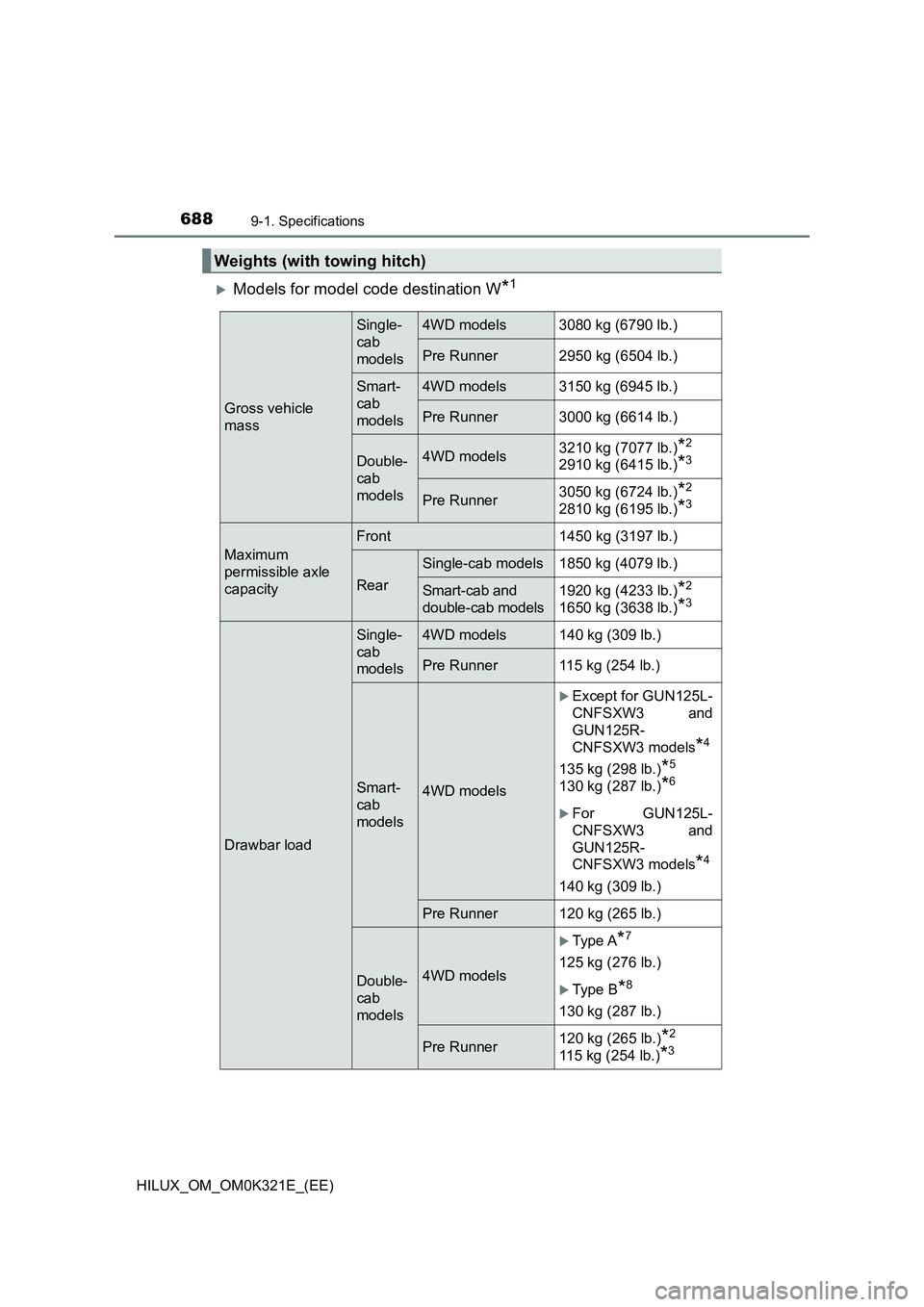
6889-1. Specifications
HILUX_OM_OM0K321E_(EE)
Models for model code destination W*1
Weights (with towing hitch)
Gross vehicle
mass
Single-
cab
models
4WD models 3080 kg (6790 lb.)
Pre Runner 2950 kg (6504 lb.)
Smart-
cab
models
4WD models 3150 kg (6945 lb.)
Pre Runner 3000 kg (6614 lb.)
Double-
cab
models
4WD models 3210 kg (7077 lb.)*2
2910 kg (6415 lb.)*3
Pre Runner3050 kg (6724 lb.)*2
2810 kg (6195 lb.)*3
Maximum
permissible axle
capacity
Front 1450 kg (3197 lb.)
Rear
Single-cab models 1850 kg (4079 lb.)
Smart-cab and
double-cab models
1920 kg (4233 lb.)*2
1650 kg (3638 lb.)*3
Drawbar load
Single-
cab
models
4WD models 140 kg (309 lb.)
Pre Runner 115 kg (254 lb.)
Smart-
cab
models
4WD models
Except for GUN125L-
CNFSXW3 and
GUN125R-
CNFSXW3 models*4
135 kg (298 lb.)*5
130 kg (287 lb.)*6
For GUN125L-
CNFSXW3 and
GUN125R-
CNFSXW3 models*4
140 kg (309 lb.)
Pre Runner 120 kg (265 lb.)
Double-
cab
models
4WD models
Type A*7
125 kg (276 lb.)
Type B*8
130 kg (287 lb.)
Pre Runner 120 kg (265 lb.)*2
115 kg (254 lb.)*3
Page 689 of 744

689
9
9-1. Specifications
Vehicle specifications
HILUX_OM_OM0K321E_(EE)
*1: See “Checking your vehicle’s model” if you are not sure of which model
your vehicle is. ( P. 12)
*2: Models made in South Africa*1
*3: Models made in Thailand*1
*4: The model code is indicated on the manufacturer’s plate or label.
( P. 691)
*5: Without rear seat cushion
*6: With rear seat cushion
*7: Except for GUN125R-DNFSXW3, GUN125L-DNFSXW3,
GUN125L-DTFSHW, GUN125L-DTFMHW, GUN125L-DTTMHW,
GUN125L-DTTHHW, GUN126L-DTTMHW and GUN126L-DTTHHW
models*4.
*8: For GUN125R-DNFSXW3, GUN125L-DNFSXW3, GUN125L-DTFSHW,
GUN125L-DTFMHW, GUN125L-DTTMHW, GUN125L-DTTHHW,
GUN126L-DTTMHW and GUN126L-DTTHHW models*4.
To w i n g
capacity
Without brake 750 kg (1653 lb.)
With
brake
Single-
cab
models
4WD models 3500 kg (7716 lb.)
Pre Runner 2800 kg (6173 lb.)
Smart-
cab
models
4WD models
Except for GUN125L-
CNFSXW3 and
GUN125R-
CNFSXW3 models*4
3350 kg (7385 lb.)*5
3200 kg (7055 lb.)*6
For GUN125L-
CNFSXW3 and
GUN125R-
CNFSXW3 models*4
3500 kg (7716 lb.)
Pre Runner 3000 kg (6614 lb.)
Double-
cab
models
4WD models
Type A*7
3050 kg (6724 lb.)
Type B*8
3200 kg (7055 lb.)
Pre Runner 3000 kg (6614 lb.)*2
2800 kg (6173 lb.)*3